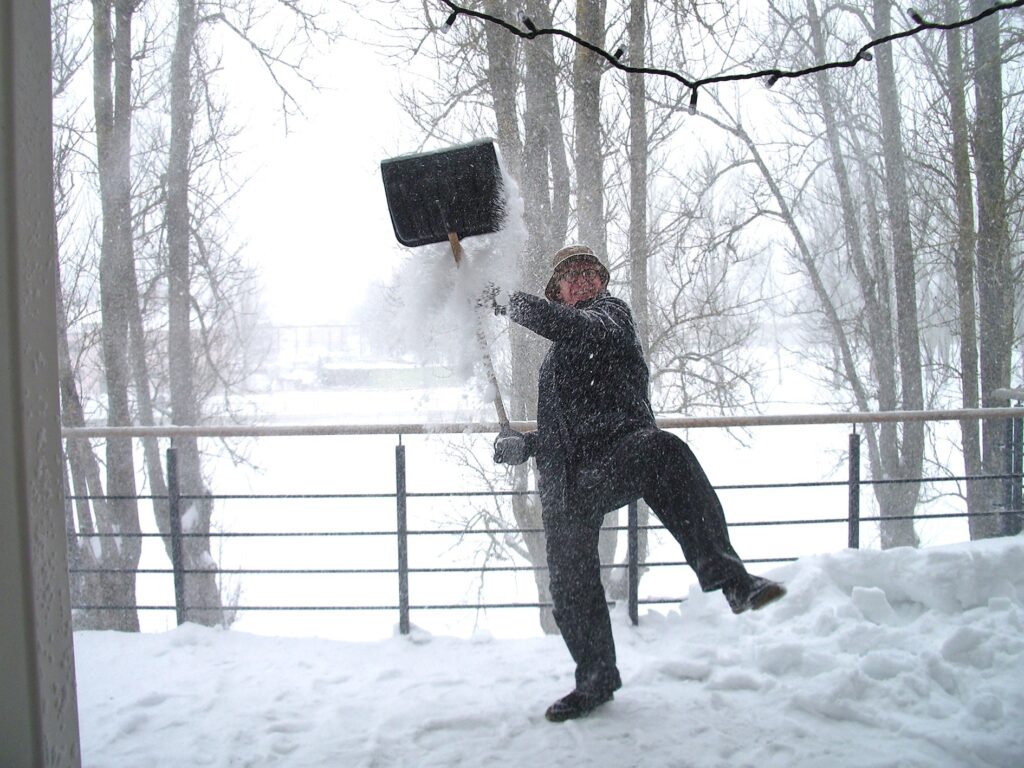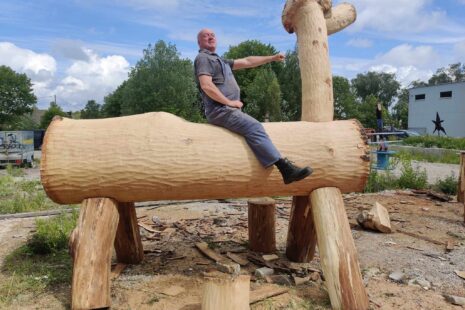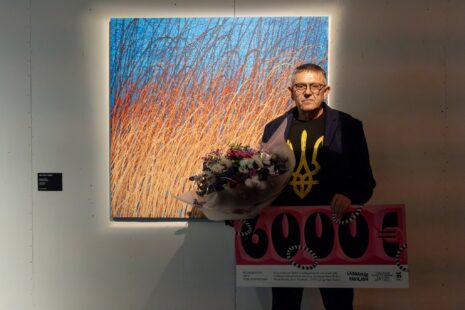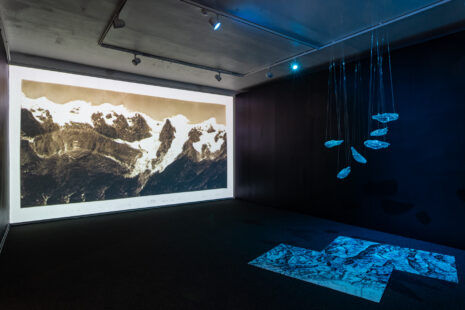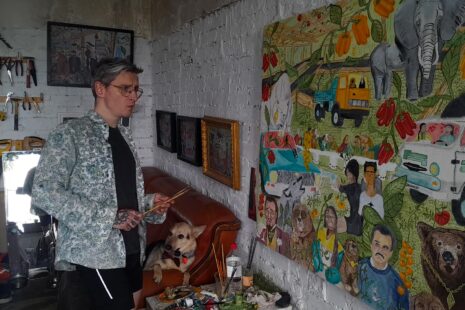You are known mainly as a sculptor, but you paint as well. At least some of your latest works seem to be in between these two mediums – in terms of material more like sculptures, in terms of format more like paintings, meant for hanging on a wall. When creating this kind of work, have you tried to „kill two birds with one stone“ or have you been just practical and thought about how the artwork could be placed comfortably at its new home?
Yes, I’ve been painting my whole life. But slowly I saw my paintings become more and more 3 dimensional. Then one day I started ”building my pictures” – what we call sculptures. And it’s not that far from me, as my original education is three-dimensional, as a corpus silversmith.
I do what I call UPjects -the missing link between painting, sculpture, graphic and ballet. As you say, flat things to the wall. In fact, it’s just a thousand year old relief tradition I’ve added to our time. On the wall, the highlighted parts provide a play in light and shadow, so the work changes character according to light and time of day. In addition, I work in several of these works with what I call indirect shadows. Painted surfaces that are not visible, but cast colored ”shadow” on parts of the work, and / or the wall.
I never have a recipient in mind when I do my work, and thus not a location either. This is just another ”tool” to tell a story with both painting and sculpture. For me, art is stories – and they can be told in several ways.

In the Stream. Mixed materials. 85 × 195 × 8 cm. 2017
In addition, you have started filming a river from your hometown – Emajõgi. Which kind of new dimension does the video give to your creation that previous tools have not succeeded to provide?
I’ve always made movies. Ever since I bought my first Super 8 camera, well when I was about 15 years old. It took a long time to save together for summer vacation works. And it’s not just river videos I make, but I’m very fascinated by the river. It lives its very own life through the four seasons. I live close to Emajõgi so I look straight into the river.
Every morning I get up and check if the water is running the right way. It happens I have to go down and change the running direction, it has to run south 😉
You could say I make two kinds of movies – the ones that are by no means planned. A snapshot of reality right now and here. One of the river videos was made in less than a day, in that very early morning, in the glare of the full moon, I went down with the camera and let things happen in front of my eyes. I was very lucky. It was a great morning. The ice was still moving, it crashed like a train down through Tartu. The sun rose in a fantastic way, and suddenly a man came with a towel and an ax. I asked if I could film him. It was no problem and I got a naked steaming ice bath in the movie The River Awakens.
Another time I hear a sound I have not noticed before, a rattle. It is autumn, and just as usual, the leaves are falling from the trees. But this is not normal, they fall off the trees so fast, that all the leaves fall off almost on the same day. Think it had something to do with severe night frost and hot morning sun. But thought it was so interesting and beautiful that it should be retained in a movie Golden Rain.
One might call these movies some kind of snapshots. I also make more planned movies, like But when do they Fire It and Diversity of Monotony. Just a few examples out of over 150 videos can be viewed on my YouTube channel.
You have worked both with bronze and silver – besides the technical and aesthetical qualities, which are the symbolic and / or energetic values of different metals?
I have worked with silver, gold, bronze, copper and brass. There is no doubt as to why silver and gold are called precious metals. They are in a league of their own, and not just because they are rare. They can be shaped like no other metals I have worked in. In particular, silver is amazing. I was an apprentice for four years at Georg Jensen Silversmith. Here I learned how flexible and shaping possible silver is. Gold is a lot more stubborn and hard -silver is very special in terms of workmanship.
I use both materials in my works, but exclusively as gold / silver leaf. Anything else would be way too expensive. I love to play with light and shadow so I get this opportunity in these metals. And at the same time I get that contrast to the raw weather I like. Decay and eternity can perhaps be set as a symbol.
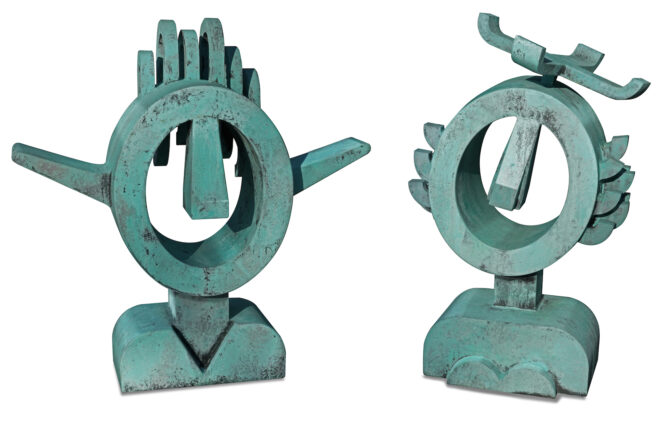
My Wife Is a Helicopter. Author’s technique. 53 × 56 × 36 cm. 2018 / I Am His Wife. Author’s technique. 50 × 38 × 34 cm. 2018
And recently you won a gold medal for your work – an Ado Vabbe Award which means that you have enriched the artistic life of the city of Tartu in a remarkable way. But what does it mean for you?
The Ado Vabbe Award means an incredible deal to me! Think about it, I cut the roots in Denmark, and tried to plant them in Tartu 16 years ago. When I did, I did not think that way, it was completely and utterly just what I HAD to do.
I worked and worked, and I still do. A lot of work does not always lead to anything, but it started to do for me artistically. And the Ado Vabbe award I received now shows me with all clarity that the transplant to Tartu was right. You almost always have the opportunity to change your life if you WANT to!
The prize was a big contribution to confirm that my decision a long time ago was the right one.
You have also won the artwork competitions for Heino Eller Music School in Tartu as well as for Virumaa College of Tallinn University of Technology. Seems like a lot of schools! Can art in a classroom promote learning and educating?
I have no doubt that art can. Art can convey and open the mind to communication! I said before that I do not think of a future customer at all when I make art. But when it comes to public art, I think a lot about where the work should stand. Who goes there and what happens on the spot. You have to keep in mind, public art is something you are forced to see, it is not like when you voluntarily enter a gallery or museum.
Take Virumaa College of Tallinn University of Technology for an example. Here we were a number of artists for a briefing meeting about what one researches. In short, in energy extraction of oil stones. I gathered the many words and films in a very simple work, so when an outsider enters the building, he or she will very quickly get a sense of what is happening on the spot. The visitor will be able to see my floating rock in three places, with the drop of oil dripping out of the rock. Explanations / words have been replaced by art.
When I had to make a work for Heino Eller Music School, the briefing at the competition was that it should be Heino Eller as a young man – one like us, as they said. I saw no reason to make something that looked like Heino Eller, a photo on a wall can handle it much better. I wanted to show the spirit in him. The joy of the music that he has passed on to the place. I imagined the student who comes to the music school on a rainy Monday, and has ”forgotten” to read the notes this weekend. The teacher who comes the same Monday, and knows that several students have probably ”forgotten” to read music over the weekend. With my work, I would like to make their mood rise when they arrive. A work that makes them happy and optimistic – with a big smile. I’ve heard it works. Yes – art can influence and teach!
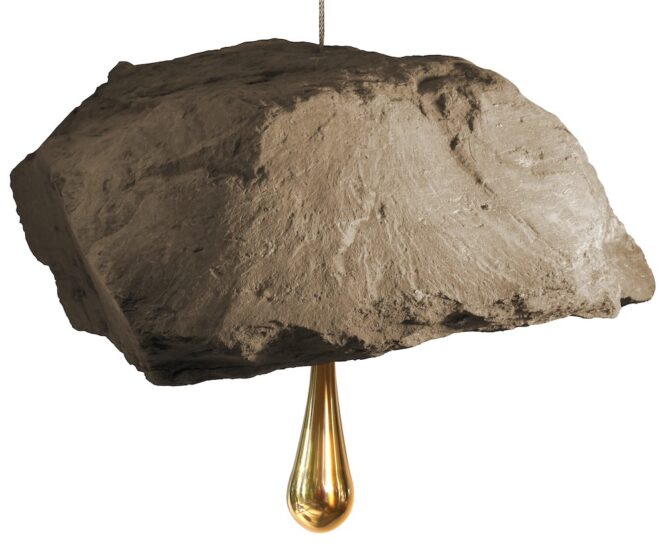
Oil Shale. 32 × 53 × 36 cm. Brass and oil stone. 2014
Ado Vabbe prize was related to your personal exhibition „Woman in Fur“ at Tartu Art House. Many of your exhibitions and separate artworks have spunky titles – how do you name them? Is there a baby born before and named thereafter or vice versa?
It is very different what comes first. But one thing is common, the work emerges from thoughts that have ”rumbled” for a while before they are ”born” as a work. So the title is always with the work, even if it is sometimes abstract at first. The titles are important to me, they complement the work, and can rarely be done with a single word. The title is part of the mood of the work. And since the world is often absurd and grotesque, you can probably find titles that are seen as the same.
Furthermore, it is my belief that we humans have an innate ”ability” to register everyday life, our surroundings, our lives, and after registering not ”seeing” it anymore – because now we have seen it, once for all. I think we get more out of our lives if we allow ourselves to see it all again – every time. But preferably in a new perspective.
I think we become enriched by maintaining our ability to experience and crave in everyday life.
It is not only long exotic journeys that can enrich us. A walk to the Coop to buy a liter of milk can also be enriching if one wants. I think that philosophy is contained in, for example, the work and the title ”Woman in Fur”.
The exhibition was accompanied by an artist book where you compared the work of the artist to a gorgeous white snow field with footprints in it. In that kind of situation an artist needs to choose whether to follow the trace or create his/her own. Which kind of imprints have you discovered this winter, which of them have you followed and which ones ignored?
Yes, it’s great with another nice clean white winter that gives the fresh new ”canvas” where absolutely everything is possible. We are still only in the middle of winter, a statement is probably a little early. But I sense the urge to follow the very first idea and sketch, instead of after rationalizing and overworking the feeling that gave the idea. The first sketch has something worth preserving, instead of seeking the ”perfect”. These are some footprints I am in the process of putting in the ”snow”.
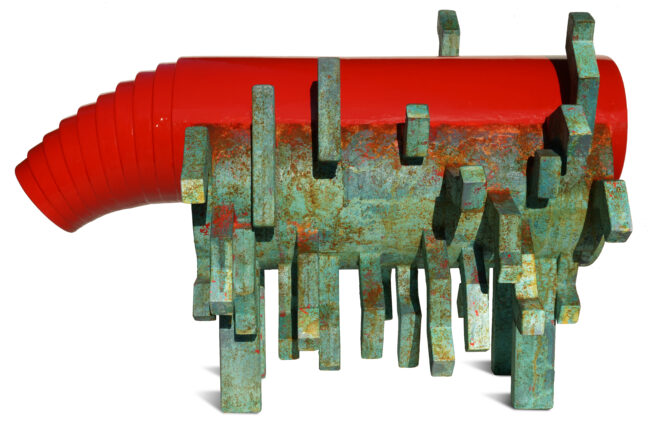
Through an Unknown Land. Author’s technique. 100 × 50 × 40 cm. 2020
In the same book Peeter Talvistu has made a note how your style is humorous and melancholic at the same time and how a laugh is a way to hide sadness. You yourself have said that humor is like sugar coat on a bitter pill which helps to swallow seriousness more smoothly. I myself would also refer to Freud who has interpreted irony as a defense mechanism of ego. What kind of bitter pills or darker sides have you immured in your sculptures or on the contrary – brought out to a bright white canvas?
The basis for my work is Man! Man in all his being, in all society layers, in all ages, in all colors, in all sexes:
greatness and imagination, fall and straightening, strength and weakness, lie and truth, courage and arrogance, greed and frugality, power and powerlessness, striving and giving up, hope and reality.
Man, you and I, and all the others!
Under these conditions a man lives, which has not become less ”interesting” in the last 20 years. Unfortunately, I have been inspired by my works in recent years, which I could not have had in my wildest imagination 40 years ago. Freedom and human vision, the human vision of power and the system, are very different from where I once thought we were heading. Absolutely unbelievable to experience the huge change, and the human will to conform to the conditions they are given. So there will be no shortage of inspiration to be swallowed with an extra sprinkle of sugar in the future.
During the completion of the exhibition and the book you counted nearly 600 artworks from the 25 year period. Though you have said that you prefer looking forward instead of looking back, I will still ask you to compare your first piece of art to the latest one and see both of them as the very same time traveler – from where did the traveler start and where is it right now?
From then until now, I see the basic tone of my works as the same, as it is the same topics that interest me. The grotesque, the absurd in the reality we have created. The different realities we sometimes do not agree on. The topics in my works are the same now and for 25 years ago. And I guess it also will be in 100 years from now.
There are 23 years between these two works. Still in family with my subjects!
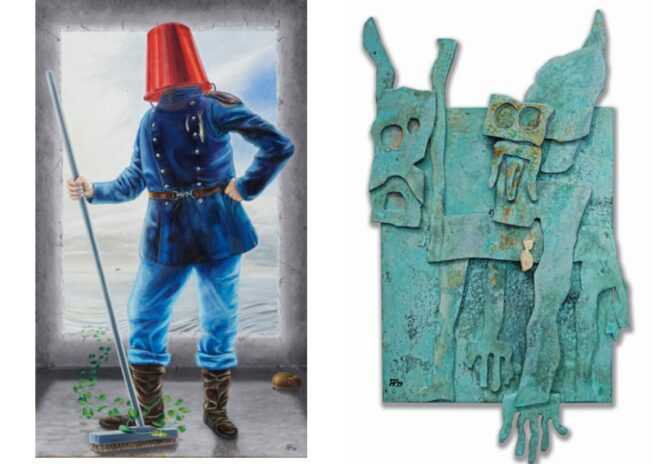
Self-Staging. Oil on canvas. 120 × 90 cm. 1996 / General Galosche. Author’s technique. 135 × 80 × 7 cm. 2019
And once more about the snow – shoveling that white mass last winter was the reason you had to postpone writing the artist book and wait for the summer. Have you modeled any snowmen this winter yet and what kind of imprints would they leave behind after melting towards the banks of Emajõgi?
It was sincerely a lovely, lyrical and picturesque question, Triinu! Feels like making a sculpture with the title, it is full of hope! And I have nothing against long titles 🙂
Yes, I do snowmen – all the time, even in the summer! I do not even want to be cured of that occupation, even though life might have been easier without it.
I hope on the way down to the Emajõgi (Mother River) my melting snowmen nourish beautiful flowers along the banks of the river, and give the fish fresh energy, for the benefit of the many fishermen, so that I may show my gratitude to the citizens of the city, who let a stranger come, and become part of an absolutely amazing place in the World! All the carrots the snowmen give will probably leave a purpose in the soups in Supilinn (Soup City, a district in Tartu) 🙂
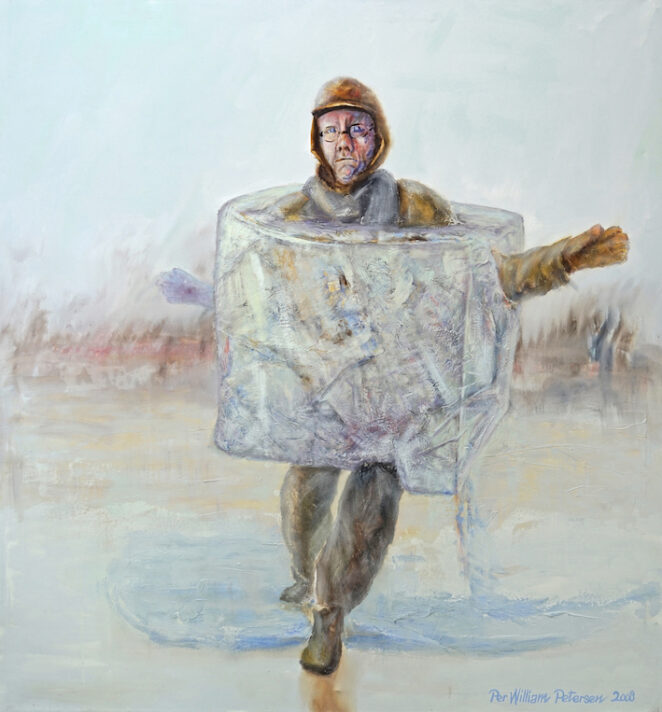
Coming to Estonia. Oil on canvas. 120 × 100 cm. 2006
Per William Petersen’s artist book “Woman in Fur. Selected works from 1995-2020” can be purchased from NOBA.ac here.

